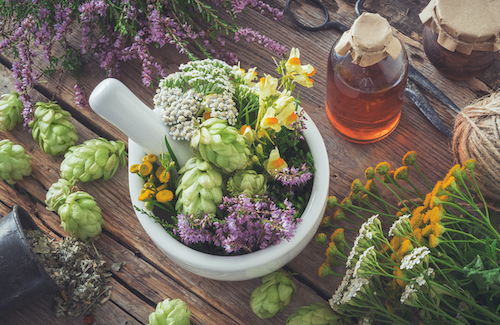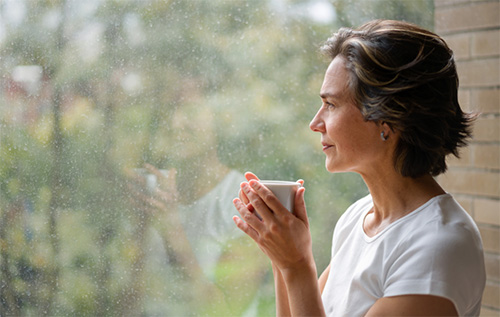Authored by Dr. Mary James, ND
We understand how disruptive menopause symptoms can be to your life — hot flashes, night sweats, weight gain, irritability, irregular periods, and worse — feeling exhausted most of the time. The good news is that when a woman comes to us looking for menopause symptom relief, we feel confident we can help her feel better with herbal remedies.

Adding targeted herbal remedies — or phytotherapy — can make a huge difference for menopause symptom relief. New research is constantly showing us how plant molecules act to balance hormones naturally, just as they have for thousands of years. Yet many women are still unsure about herbs, including their safety and effectiveness. After all, we’ve been told that real relief can only come from prescription medications.
The truth is that phytotherapy is both safe and effective and — in my experience — one of the best ways to restore hormonal balance and help relieve symptoms. Here’s what I tell my patients:
Why are herbal remedies for menopause so effective?
During perimenopause and menopause, we experience symptoms when extreme shifts occur in the sex hormones estrogen, progesterone and testosterone. When hormonal ratios and balance are disrupted beyond their normal ranges, you may first sense that something is “off” or “not quite right” in your body and wonder “is it menopause?” As hormonal imbalance intensifies, you will begin to suffer from symptoms ranging from mild to severe.
One reason phytotherapy is so effective is that certain herbs (known as phytocrines) share important features with natural hormones, thus enabling them to increase the body’s natural ability to make and use hormones and provide symptom relief.

Sometimes women ask me if phytoestrogens will increase estrogen in the body. But phytoestrogens, such as the isoflavones in soy and red clover, aren’t really estrogen. They don’t add to the amount of actual estrogen in your body, nor do they behave in exactly the same way as your body’s own estrogen. In fact, phytoestrogens help to normalize estrogen action in the body, partly because their estrogen-like action is very weak. They work to block the potentially damaging effects of excess estrogen, but also boost estrogen-like action in a woman with low estrogen levels.
Help without side effects
Because phytotherapy works with your body, it can powerfully alleviate your worst symptoms, but without the side effects. If we’re used to medicines taking immediate effect, just keep in mind that the healing qualities of phytotherapy are usually more subtle — but they are working!
Evidence for phytotherapy is strong. Naturopathic physician Tori Hudson reminds us that using herbal remedies for menopause isn’t a new concept in her article on Menopause Botanicals. As Dr. Hudson explains, “Many herbs have been used traditionally by herbalists and women for decades, and in some cases centuries, to address menopausal symptoms. Although many of the traditionally used plants lack clinical studies for this purpose, the empirical evidence and tradition [are] strong.”
Top 9 herbs for menopause symptom relief
Herbs that are especially powerful are the “adaptogens,” meaning that their actions are geared to what YOU need, based on your own unique hormonal concentrations and fluctuations.
With its adaptogenic effects, phytotherapy can help normalize, strengthen, and protect your system from the effects of stress in menopause and further down the road. Certain herbs are highly effective for specific symptoms:
| Herb | Especially helpful for… | How it works with your hormones |
|---|---|---|
| Black Cohosh (Actaea racemosa)  |
|
Black cohosh may act as a hormone imitator, binding to opioid receptors in the brain, and possibly influencing serotonin levels. |
| Red clover (Trifolium pratense)  |
|
By weakly binding to estrogen receptors in the body, red clover’s phytoestrogens help normalize estrogen action. Its phytoestrogens include lignans, coumestans, and isoflavones. |
| Chaste tree berry (Vitex agnus-castus)  |
|
Chaste tree contains molecules that may affect our neurotransmitters, which act in the brain and other parts of the body. It also helps regulate the menstrual cycle during perimenopause, which is one way it may enhance progesterone production in the body. |
| Kudzu (Pueraria lobata)  |
|
Kudzu contains phytochemicals that function in a protective fashion. These include five major isoflavonoids that can bind weakly to estrogen receptors. |
| Passionflower (Passiflora incarnata)  |
|
Contains natural monamine oxidase inhibitors (MAOIs), which are known to have antidepressant and anti-anxiety properties. |
| Ashwagandha (Withania somnifera)  |
|
Studies suggest that ashwagandha acts in an adaptogenic fashion to balance adrenal hormones and androgens by activating the hypothalamic-pituitary-gonadal axis. |
| Wild yam (Dioscorea villosa)  |
|
While the underlying mechanisms for the effects of wild yam are not well-defined, one theory suggests that it may act as either a precursor to or a functional imitator of sex hormones such as progesterone. |
| Soy (Glycine max)  |
|
The phytoestrogens in soy help reduce menopausal symptoms by counterbalancing low and/or fluctuating estrogen levels. |
| Maca (Lepidium meyenii)  |
|
Although maca does not appear to alter actual hormone levels, its benefits on menopausal symptoms have been noted for centuries. |
(Images courtesy of Natural Standard, international research collaboration on integrative medicine.)
Making herbs work to relieve your menopause symptoms
The truth is a one-size-fits-all cure for menopause symptoms simply doesn’t exist, since every woman is unique and menopause symptoms can vary dramatically. I often recommend a variety of herbs because diversity offers the benefits of several plants in small doses, as opposed to delivering one big hit that might not be the most appropriate herb for a particular woman. Science also suggests that combination formulations, like Herbal Equilibrium, work in an adaptogenic way to restore hormonal balance within a range of variable circumstances.
With a little patience and the right herbal remedies, your body can even repair hormonal pathways that have been off-balance for many years, even if your menopause symptoms are severe.
References and further reading
Starfield, B. 2000. Is US health really the best in the world? JAMA, 284 (4), 483–485. (accessed 02.11.2008).
Leape, L. 1992. Unnecessary surgery. Annu. Rev. Public Health, 13, 363–383.
Phillips, D., et al. 1998. Increase in US medication-error deaths between 1983 and 1993. Lancet, 351, 643–644.
Lazarou, J., et al. 1998. Incidence of adverse drug reactions in hospitalized patients. JAMA, 279, 1200–1205.
Weingart, S., et al. 2000. Epidemiology and medical error. BMJ, 320, 774–777.
The Cancer Cure Foundation. Medical errors — a leading cause of death. URL: https://www.cancure.org/medical_errors.htm (accessed 02.06.2008).
The World Health Organization. 2003. WHO | Traditional Medicine. Fact Sheet No. 134. URL: https://www.who.int/mediacentre/factsheets/fs134/en/ (accessed 02.11.2008).
Wikipedia. 2008. Endocrine system. (accessed 01.23.2008).
Collins, J. Winter, 2006. Phytotherapeutic management of endocrine dysfunctions. NutriNews, pp. 1–4, 6–8. URL: https://www.douglaslabs.com/pdf/nutrinews%5CEndocrine%20Dysfunctions.pdf (accessed 12.19.2007).
Hudson, Tori. 2006. Menopause Botanicals. (accessed 02.11.2008).
Wikipedia.org. 2008. Kudzu. (accessed 02.11.2008).
Wikipedia.org. 2008. Passiflora. (accessed 02.11.2008).
Newton, K., et al. 2006. Treatment of vasomotor symptoms of menopause with black cohosh, multibotanicals, soy, hormone therapy, or placebo. Ann. Int. Med., 145 (12), 869–879. (accessed 02.11.2008).
Both, L., & Yang, Q. 2000. 5,10–Methylenetetrahydrofolate reductase gene variants and congenital anomalies: A HuGE review. Am. J. Epidem., 151 (9), 862. (accessed 02.11.2008).
Esfahani et al. 2003. Heterogeneity in the prevalence of methylenetetrahydrofolate reductase gene polymorphisms in women of different ethnic groups. J. Am. Diet. Assoc., 103 (2), 200-207.
Mai, Z., et al. 2007. Soy phytochemicals synergistically enhance the preventive effect of tamoxifen on the growth of estrogen-dependent human breast carcinoma in mice. Carcinogenesis, 28 (6), 1217–1223. (accessed 02.11.2008).
Limer, J. & Speris, V. 2004. Phyto-oestrogens and breast cancer chemoprevention. Breast Cancer Res., 6 (3), 119–127. (accessed 02.08.2008).
Magee, P. & Rowland, I. 2004. Phyto-oestrogens, their mechanism of action: Current evidence for a role in breast and prostate cancer. Br. J. Nutr., 91 (4), 513–531. (accessed 02.08.2008).
Adlercreutz, H. 2002. Phyto-oestrogens and cancer. Lancet Oncol. 3 (6), 364–373. (accessed 02.08.2008).
Collins, J. 2000. Discover Your Menopause Type, pp. 212–219. NY: Three Rivers Press.
Messina, M, et al. 1994. Soy intake and cancer risk: A review of the in vitro and in vivo data. Nutr. Cancer, 21 113–131.
Atteritano, M., et al. 2007. Effects of the phytoestrogen genistein on some predictors of cardiovascular risk in osteopenic, postmenopausal women: a two-year randomized, double-blind, placebo-controlled study. J. Clin. Endocrinol. Metab. 92 (8), 3068–3075. (accessed 02.11.2008).
Zhang, X., et al. 2003. Soy food consumption is associated with lower risk of coronary heart disease in Chinese women. J. Nutr., 133 (9), 2874–2878. (accessed 02.11.2008).
Potter S, et al. 1998. Soy protein and isoflavones: Their effects on blood lipids and bone density in postmenopausal women. Am. J. Clin. Nutr., 68 (Suppl.), 1375S–1379S.
Ma, D., et al. 2008. Soy isoflavone intake increases bone mineral density in the spine of menopausal women: Meta-analysis of randomized controlled trials. Clin. Nutr., 27 (1), 57–64. (accessed 02.18.2008).
Ma, D., et al. 2008. Soy isoflavone intake inhibits bone resorption and stimulates bone formation in menopausal women: Meta-analysis of randomized controlled trials. Eur. J. Clin. Nutr., 62 (2), 155–161. (accessed 02.11.2008).
Marini, H., et al. 2007. Effects of the phytoestrogen genistein on bone metabolism in osteopenic postmenopausal women: A randomized trial. Ann. Intern. Med., 146 (12), 839–847. (accessed 02.11.2008).
Further reading
For more answers to questions on the minds of women regarding the safety and efficacy of medicinal herbs, you may wish to visit the FAQ page on herbs at the website of the American Herbal Products Association (AHPA), whose mission includes supporting the responsible commerce of herbal products and ensuring that consumers enjoy informed access to herbal products.
For more information on medicinal herbs, we encourage you to visit the Natural Standard website. Natural Standard is an international research collaboration that aggregates and synthesizes data on integrative medicine, offering an expansive resource on complementary and alternative therapies, including phytotherapy: https://naturalmedicines.therapeuticresearch.com









